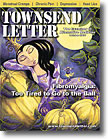


From the
Townsend Letter |
||
Recent Progress in Clinical Applications |
||
Continued. . . 1, 2, 3, 4, 5, 6, 7, 8, 9, 10, 11, 12
Chart 12: Methods/Assessment Group I – Excellent, positive
outcome, patients whose pain was reduced 75% in 72 hours and may
require minor over-the-counter pain
medication. Group III – Fair, positive outcome, patients with 50% reduction in pain, requiring a second procedure within 14 days. Group IV – Poor, negative outcome, patients with less than 50% reduction in pain after 14 days and with a second antimicrobial protocol.
Chart 13: Outcome from Open Clinical Study Group I – positive outcome, excellent, ten patients, 23.8%. Group II – positive outcome, good, 26 patients, 61.9%. Group III – fair outcome, four patients, 9.5%. Group IV – poor outcome, two patients, 4.8%. Total positive response 95.23%. Figure 12 (12KB .pdf) shows the above results in graph form.
DETECTION OF FUNGUS FROM BLOOD SAMPLES Non-culture methods now being developed and evaluated for mycotic infections include High Resolution Blood Morphology (HRBM™), polymerase chain reaction (PCR), galactomannan antigenemia, Western blot to detect antibodies, and other methods to detect the fungal metabolites D-arabinitol and (1,3)-beta-D-glucan. Sample preparation for PCR from blood specimens depends on fractionation of peripheral blood, its pre-incubation in blood culture broth, or a total DNA method that does not rely on fractionation or pre-incubation. A pilot study indicated that PCR tests on blood specimens were positive at least once in patients with confirmed invasive aspergillosis. Produced by most general of pathogenic fungi, (1,3)-beta-D-glucan can be detected in plasma by the "G-test."106 High Resolution Microscopy, PCR, and the G-test are the most reliable. Antibody detection is the least reliable, giving significantly false, negative results.77,123 The PCR method was capable of detecting a wide range of medically important fungi from clinical specimens. The test is based on the detection of certain ribosomal RNA genes shared by most fungi. The lower limit of detection was 1 pg (picogram) of Candida albicans genomic DNA. A 687-bp (base-pair) product was amplified successfully by PCR from all 78 strains of 25 medically important fungal species, including Candida, Hansenula, Saccharomyces cerevisiae, Cryptococcus neoformans, Trichosporon beigelii, Malassezia furfur, Pneumosystis carinii, Aspergillus sp., and Penicillium sp. Detection by PCR of fungus in clinical samples including blood, cerebrospinal fluid, and sputum appeared to be a more sensitive diagnostic method for fungal infections than a conventional blood culture technique.107 In a two-year study, 121 patients admitted to the University Hospital of Innsbruck, Germany, for cancer chemotherapy, without clinical signs of fungal infection, were screened for Aspergillus. In 23% of these patients, Aspergillus was detected by the PCR method. Positive PCR results became negative shortly after antifungal treatment was begun.108 Diagnosing the invasion of deep organs by Candida has been difficult for two reasons. First, patients may have extensive Candida infections of several deep organs, yet have negative blood cultures. Second, the meaning of a positive blood culture for Candida has been questioned, especially during the early years of the organism's emergence as a pathogen. There is a crucial need for an accurate, cost-effective test more sensitive than blood cultures for diagnosing Candida infections of deep organs. Inevitably, however, invasive candidiasis will develop in some patients who will die before they test positive.131 This demonstrates that the blood culture test alone is both unreliable and insensitive.
THERAPY Broad-Base Antimicrobial Infusion Aerobic Exercise
|
||
![]()
Consult your doctor before using any of the treatments found within this site.
![]()
Subscriptions are available for Townsend Letter, the Examiner of Alternative Medicine magazine, which is published 10 times each year.
Search our pre-2001
archives for further information. Older issues of the printed magazine
are also indexed for your convenience.
1983-2001
indices ; recent indices
Once you find the magazines you'd like to order, please use our convenient form, e-mail subscriptions@townsendletter.com, or call 360.385.6021 (PST).

All rights reserved.
Web site by Sandy Hershelman Designs
